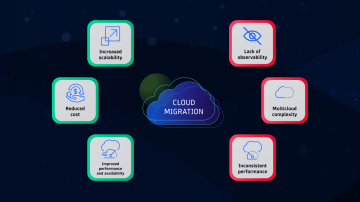
Like any move, a cloud migration requires a lot of planning and preparation, but it also has the potential to transform the scope, scale, and efficiency of how you deliver value to your customers.
More organizations than ever are undertaking cloud migration as digital transformation continues to gain momentum across every industry in every region. Cloud services platforms like AWS, Azure, and GCP are reshaping how organizations deliver value to their customers, making cloud migration an increasingly attractive option for running applications.
But what does it take to migrate your existing applications to the cloud? We’ll answer that question and explore cloud migration benefits and best practices for how to go through your migration smoothly.
What is cloud migration?
Cloud migration is the process of transferring some or all your data, software, and operations to a cloud-based computing environment that offers unlimited scale and high availability. Generally speaking, cloud migration involves moving from on-premises infrastructure to cloud-based services. However, it can also mean migrating from one cloud to another.
In cloud computing environments, infrastructure and services are maintained by the cloud vendor, allowing you to focus on how best to serve your customers. Like any move, a cloud migration requires a lot of planning and preparation, but it also has the potential to transform the scope, scale, and efficiency of how you deliver value to your customers.
Three reasons organizations migrate to the cloud
Organizations migrate to the cloud for a number of reasons. Here are three.
1. Accelerate digital transformation
When Gartner asked CEOs about their top five strategic business priorities for the next two years, the majority of responses included one simple word: digital.
Digital transformation, the process of integrating digital technology into all areas of a business, is a foundational change in how modern organizations deliver value to customers and improve internal processes. When organizations digitally transform, they often experience increased profit, higher customer engagement, and ultimately, the ability to deliver the best solutions possible to users.
A key step in digital transformation is migrating from traditional on-prem IT processes to adopting cloud services. The breadth of fully-featured services, the pay-as-you-go scalability, and the agility of cloud platforms enable organizations to expand their modern approaches to building and managing digital services in a way they can’t with on-premises apps and infrastructure. Cloud migration can also be an opportunity for organizations to embrace green-field technologies and projects from the ground up. This can fundamentally transform how they work, make processes more efficient, and improve the overall customer experience.
2. Drive business value and avoid operational cost and risk
Another key driver of cloud migration is an organization’s desire to increase business value and avoid operational cost and risk. In the traditional IT model, there’s significant operational and capital expenditure involved. It requires purchasing, powering, and configuring physical hardware, training and retaining the staff capable of servicing and securing the machines, operating a data center, and so on. With this overhead, it can take weeks to set up a basic project.
A cloud migration strategy, however, provides technical optimization that’s also firmly rooted in the business value chain. Migrating to a cloud provider can alleviate the overhead costs of traditional IT infrastructure. With cloud-based resources, teams can spin up infrastructure in seconds, begin testing immediately, scale up or down as needed, and easily eliminate resources that are no longer needed. This flexibility allows organizations to continue delivering on core value propositions while paying only for what they use.
3. Decrease security risks
With a constant barrage of companies making negative headlines due to hacks, security breaches, leaked consumer data, and other security risks, security is a constant concern. With an on-prem data center, the organization bears the burden of securing the physical infrastructure and its digital assets. Migrating to the cloud is a strategy many organizations pursue to streamline and consolidate their security efforts.
Many cloud providers offer a shared security model of data security and compliance in which the cloud provider bears the responsibility for securing the underlying infrastructure, and the customer is responsible for the security of their data, code, and related workloads. In this shared-responsibility model, companies can focus their security efforts on their core business and benefit from more robust overall security measures.
Benefits of migrating to the cloud
Under the traditional data center model, companies need to invest substantial resources to determine exactly the right amount of physical infrastructure to have on hand and maintain it once it’s in place. They need enough hardware to serve their anticipated volume and keep things running smoothly without buying too much or too little.
The flexibility of cloud environments eliminates this guesswork. Here are three major benefits of cloud migration:
1. Increased scalability
From a scalability perspective, cloud providers offer computing resources as they are needed, enabling organizations to scale with demand. In case of a spike in traffic, you can automatically spin up more resources, often in a matter of seconds.
Likewise, you can scale down when your application experiences decreased traffic. This flexible scalability allows a “Goldilocks” scenario: having the exact right amount of compute capacity right when you need it.
2. Reduced cost
Cloud providers manage all the underlying hardware, server maintenance, and security practices, allowing you to spend less on expensive IT operations and maintenance.
Additionally, the concept of scalability cloud providers offer is closely tied to the cost to run your application, and their pricing follows a pay-as-you-go model. With cloud computing, your costs will vary based on how much of the resource or service you utilize. Therefore, users must remember that although overall the cost is lower than traditional IT infrastructure, the cost of cloud computing will always align and be reflective of the demand. For example, as traffic increases, costs will too. But often, increased traffic also means increased conversions, and as a result, increased revenue.
3. Improved performance and availability
The third big advantage of cloud migration is performance and availability. A major problem of traditional IT environments is the amount of downtime – planned or unplanned – which inevitably impacts performance and availability. Compared to traditional IT environments or data centers, cloud computing environments perform behind-the-scenes maintenance, which has made outages a rarity.
Using cloud services, companies can maintain a variety of distributed services across multiple clouds in regional data centers across the globe. This can dramatically decrease network latency and its effect on the end-user experience. As a result, organizations are seeing improved availability and performance.
Cloud migration challenges
While there are many cloud migration benefits, organizations also face some common challenges during the process. The three biggest roadblocks are often:
- Lack of observability. Because cloud environments are dynamic and distributed, gaining adequate visibility into them and the services that run on them is more difficult than on-prem data centers. To solve this, organizations need to adopt a comprehensive observability strategy.
- Multicloud complexity. Most organizations span between on-prem resources and the cloud. Many also adopt more than one cloud platform to meet different needs. As such, organizations need the ability to integrate and monitor activity across their hybrid- and multicloud environments.
- Inconsistent performance. Because cloud architectures are more distributed and dynamic resources come and go as needed, performance can be varied. This requires organizations to architect their systems carefully and to continuously monitor to quickly detect slowdowns before they affect users.
The good news is, if you anticipate these challenges from the outset, you can develop a proactive strategy that addresses both factors, which will help you avoid any associated downtime and get the organization up and running quickly.
Best practices for a successful cloud migration
For an on-premises-to-cloud migration, here are five best practices to keep in mind for planning and implementing a seamless migration that meets the desired outcomes.
- Establish a clear set of goals and outcomes. By establishing these, you can work backward to ensure every step of the process is designed to serve these outcomes. If not, table it as a nice-to-have for later.
- Inventory your technology and service stack and its dependencies. By understanding exactly what technologies you have, where they run, and what services depend on them, you can determine their condition and how they’re used so you know how best to upgrade, replace, and plan for their migration.
- Analyze your resource consumption and traffic patterns. To understand how best to architect your cloud environment, you also need to understand how traffic flows across your technology and service stack. With this understanding, you can streamline and optimize how data is transferred, and model traffic patterns for migration planning.
- Migrate databases intelligently. All applications require access to databases, so databases and the services that depend on them should be migrated in tandem. This is also an opportunity to profile your database traffic, so you clearly know your database needs in the migrated environment.
- Migrate by function rather than by resource. This takes a business-driven approach to migration, for example, moving services closer to users for better response times, or moving an infrequently used service to an on-demand cloud instance to save on resources.
- Carefully plan and understand your company’s security strategy as you move to the cloud. Cloud migrations often involve the transfer of data from one location to another and, like the transferring of valuables in the physical world, the source, transformation method, and destination must be secure at every step of the way, as data is especially vulnerable in transit.
- Ensure you have all the quality checks set up in the new environment. Before deactivating the old customers and transferring traffic to the new cloud provider, it is important to set aside time to “break-in” the new environment. Leverage this time t’s kick the tires and ensure everything is working before leaning on it to support users.
When done correctly, cloud migration is invisible to your customers with no downtime and no new bugs.
How to effectively manage a cloud migration
Clearly, the process of migrating to the cloud offers numerous benefits, but it also requires careful planning and the right resources for implementation. Dynatrace provides the tools and capabilities that allow you to execute your cloud migration strategy smoothly and successfully.
With automatic discovery from OneAgent, automatic topology mapping from Smartscape and precision analysis from the Davis AI engine, Dynatrace makes it easy to analyze your technology and service stack. This insight helps you and understand your traffic and utilization patterns for migration planning and execution.
Dynatrace tames cloud complexity with automatic and intelligent observability across multicloud environments. With high fidelity intelligence about the state of your systems and services before, during, and after migration, you can instantly pinpoint availability and performance issues and understand their upstream and downstream effects before users are impacted.



